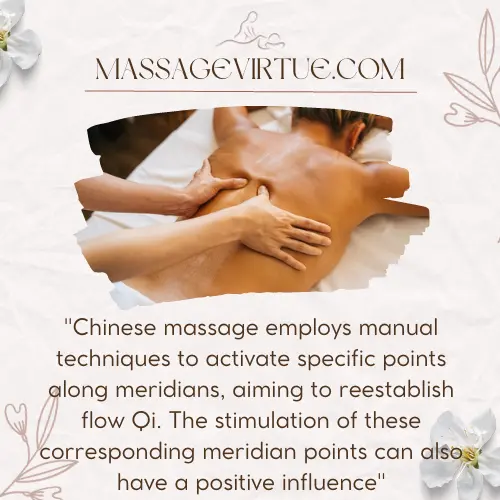Among the most revered are Chinese and Thai massages. These two modalities, while both rooted in the wisdom of centuries-old practices, offer unique experiences that cater to distinct needs.
Understanding the difference between Chinese and Thai massage is the key to choosing the right path towards rejuvenation.
In this article, we delve into the world of these time-honored techniques, unraveling the distinctive approaches that make each a treasure trove of wellness.
What Is Thai Massage?
Thai massage, also known as “Nuad Bo Rarn” in Thailand, is a traditional therapeutic practice that focuses on harmonizing the body’s energy pathways.
Unlike some other forms of massage, Thai massage is typically performed with the recipient fully clothed in loose, comfortable attire.

It involves a combination of acupressure, stretching, and applied yoga-like poses to enhance flexibility, release tension, and promote overall well-being.
This ancient practice is valued for its ability to not only address physical discomfort but also for its potential to improve mental and emotional balance.
Thai massage is a popular choice for those seeking a holistic approach to wellness and relaxation.
What Is Chinese Massage (Tui Na)?
Chinese massage, often referred to as “Tui Na,” is a traditional healing modality rooted in Chinese medicine.
This therapeutic practice is built upon the principles of meridian and acupressure therapy, with a focus on stimulating specific points in the body to regulate the flow of Qi (energy).
Chinese massage incorporates various hand techniques to address both physical and internal health issues, making it a versatile and holistic approach to well-being.
It is known for its gentle and soothing nature, making it suitable for a wide range of clients, including those with sensitivities to pressure, chronic conditions, or injuries in need of gentle care.
Chinese massage offers a unique blend of relaxation and targeted healing, making it a valuable component of traditional Chinese medicine
Difference Between Chinese And Thai Massage?
Technique:
Chinese massage: Chinese massage employs manual techniques to activate specific points along the meridians, aiming to reestablish the flow of Qi within the body.
The stimulation of these corresponding meridian points can also have a positive influence on internal organs and bodily systems, resulting in increased vitality and enhanced immune function.

Thai Massage: This type of massage utilizes stretching and targeted pressure, traditional Thai massage manipulates the Sen lines to alleviate tension and clear blockages within the joints and muscles.
Stimulating Sen lines associated with various aspects of the mind has the potential to influence the recipient’s emotional and mental well-being.
Setting:
Chinese massage: Providing Chinese massage on specialized couches or tables enhances the overall comfort and relaxation for clients.
The use of these soft and convenient mats on the surface offers an ideal option for those who prefer to recline during their massage session.
Thai massage: In the practice of Thai massage, practitioners utilize a mat placed on the floor during therapy sessions.
Clients have the flexibility to either sit on the mat or assume various positions that involve stretching and movement.
This approach allows the therapist to effectively use their own body weight to apply increased depth and pressure in Thai massage, facilitating enhanced flexibility and tension relief for the client.
Focus:
Chinese massage: Chinese massage places its emphasis on precise areas of the body, making it an effective method for addressing particular health concerns such as back pain, digestive problems, headaches, and migraines.
Thai massage: Thai massage encompasses the entire body, with a focus on enhancing both physical and mental well-being.

Skilled practitioners employ Thai techniques to enhance posture, elevate mood, increase flexibility, boost energy levels, and improve the quality of sleep
Ingredients & Equipment:
Chinese massage: Chinese massage often incorporates herbal oils and lotions, enabling recipients to experience the therapeutic properties of these herbs, such as anti-inflammatory, relaxation, or pain-relief effects.
In addition to traditional massage, sessions may involve the use of other techniques and tools like acupuncture, cupping, or moxibustion equipment.
These modalities utilize needles, suction, and heat applied to specific points on the body, effectively enhancing the stimulation of Qi and promoting improved blood circulation.
Thai massage: Thai massage differs from other massage modalities as it abstains from using oils or lotions. Instead, it relies on compression and dry friction to achieve the intended therapeutic effects.
The avoidance of lotions and oils is deliberate, as they can impede the therapist’s ability to apply pressure and maintain a secure grip with their feet or hands, which is vital for effectively stimulating energy and Sen lines.
Clothing:
Chinese massage: During Chinese massage sessions, it is common for therapists to request that clients either partially or fully disrobe and drape themselves with a sheet or towel for the duration of the treatment.
Thai massage: In the practice of Thai massage, clients typically have the option to retain their clothing, provided they wear loose and comfortable attire during the session.
Intensity:
Chinese massage: Chinese massage is known for its soothing and gentle approach, making it well-suited for individuals who are sensitive to intense pressure.

Moreover, those dealing with chronic conditions or injuries that require a gentle touch can find Chinese massage to be a beneficial and enjoyable option.
Thai massage: Thai massage is often characterized by its vigorous and intense nature, as therapists apply significant pressure to the Sen lines.
This type of massage is particularly beneficial for clients with tight muscles that require intense manipulation or for individuals seeking a deep-tissue massage experience.
Conclusion:
In the realm of holistic well-being, the difference between Chinese and Thai massage becomes not only a matter of choice but also a gateway to diverse therapeutic experiences.
Chinese massage, with its gentle precision, provides solace for those seeking a soothing touch, while Thai massage, with its dynamic intensity, offers a powerful release for tight muscles and minds.
These ancient practices are a testament to the profound connection between body, mind, and soul, reminding us that the path to wellness can be as varied and unique as the individuals who seek it.
The choice is yours, and the journey promises the revitalization you seek.

